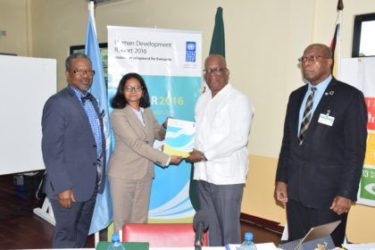Guyana ranked at 127 out of 188 countries on the UN’s Human Development Index (HDI) as of 2015, an increase of 17.9% from 1990, but Minister of Finance Winston Jordan cautioned that this is nothing to be celebrated, but rather, it simply serves as a reminder that harder and smarter work must be done to “conquer the scourge of poverty”.
Speaking at the launching of the Human Development Report titled “Human Development for Everyone”, at the New Lecture Theatre of the University of Guyana yesterday, Jordan said, “This flagship report is a significant advancement in the measure of progress of our country. We must be led by national needs, balanced with global responsibilities. Every man, woman and child, no matter where they may be in their lifecycle, must be able to enjoy a good quality of life.” He added that if each stakeholder played his/her part, the “good life” can be experienced by all.
The report gives Guyana’s HDI ranking as 0.638%, which it noted is a 17.9% increase from its 0.541 ranking in 1990. According to the report, once adjusted for inequalities that result from the “distribution of the HDI dimension indices,” Guyana’s 0.638 ranking falls 0.518, an 18.8% loss.
According to the United Nations Development Programme’s (UNDP) website, the HDI was created “to emphasize that

people and their capabilities should be the ultimate criteria for assessing the development of a country, not economic growth alone”. As such, the index considers three criteria: long and healthy life, knowledge and a decent standard of living.
Presenting the report from the Guyana context, UNDP Programme Specialist Patrick Chesney stated that as far as health goes, life expectancy at birth for Guyanese was 66.5 years; the adult mortality rate for females was 173 per 1,000 women; and the corresponding number for males was 250. The infant mortality rate as of 2015 was 32 deaths for every 1,000 live births and the under-five mortality rate was 39.4 for every 1,000 live births.
In terms of education, the number of years a child could expect to receive schooling was recorded as 10.3. This took into account the fact that although the gross enrolment ratio for children entering preschool, primary school and secondary school stood at 94%, 85% and 89% respectively, only 12% of the tertiary-aged population actually enrolled in a tertiary institution. Furthermore, the primary school dropout rate was 7.8%. Perhaps as a consequence, Guyana’s adult literacy rate, calculated for ages 15 and older, was said to be 88.5% at the time of research.
The gross domestic product (GDP) per capita was calculated at $7,064. The GDP total at 2011 purchasing power parity (2011 PPP$) was $5.4 billion. The gross national income (GNI) per capita 2011 PPP$ was $6,884.
Under the Gender Development Index, an adolescent birth rate of 88 births for every 1,000 women between the ages of 15 to 19 existed, and for every 100,000 births, 229 women die from pregnancy related causes the report said.
The GNI per capita for females was calculated at $4,346, while the same value for their male counterparts were more than twice that number, at $9,397.
In terms of labour force participation, 41.8% of females 15 and older worked, while males far outnumbered in that age range in the work force with a percentage of 77.2%.
UNDP Deputy Resident Representative Shabnam Mallick stated that the 2016 HDR builds on the 2030 agenda and explains “who has been left behind in the development process and why”. She further stated that even with Guyana’s progress, the country still continues to face “chronic difficulties” in three areas, those being in relation to transforming natural wealth into human development, developing the hinterland, and social inclusion and cohesion.
In his speech, Jordan had noted that if poverty was to be “conquered” a conscious and deliberate effort must be put toward the allocation of resources toward achieving the desired results.
Addressing the danger of viewing a country’s development one-dimensionally, Jordan questioned: “…Should a middle income country, like Guyana, based purely on per capita income and ranked 127th on the 2016 HDI, be considered ineligible for development partner support? Should Guyana be denied continued access to concessional resources because its per capita income has increased, even though significant geographical and other inequalities exist, even as the government continues to grapple with, for example, an education system that leaves 87 per cent of our 11 year olds unable to accomplish the most basic of numeracy skills while another 75 per cent is unable to comprehend their own language? The answer to whether a single dimension indicator should be used is obviously a resounding no.”
He added, “And we will continue the struggle with like-minded partners to fashion a more-appropriate, all-embracing, universally-accepted measure.”
The full Human Deve-lopment Report can be accessed at hdr.undp.org.




